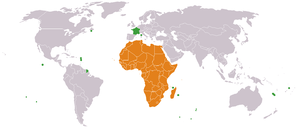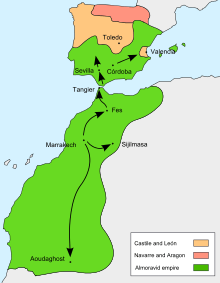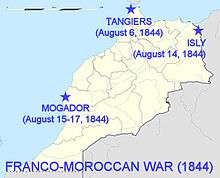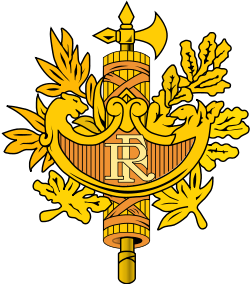France–Africa relations

France–Africa relations cover a period of several centuries, starting around in the Middle Ages, and have been very influential to both regions.
First exchanges (8th century)


Following the invasion of Spain by the Berber Commander Tariq ibn Ziyad in 711, during the 8th century Arab and Berber armies invaded Southern France, as far as Poitiers and the Rhône valley as far as Avignon, Lyon, Autun, until the turning point of the Battle of Tours in 732.[1]
Cultural exchanges followed. In the 10th century, the French monk Gerbert d'Aurillac, who became the first French Pope Sylvester II in 999, traveled to Spain to learn about Islamic culture, and may even have studied at the University of Al-Qarawiyyin in Fez, Morocco.[2]
France would become again threatened by the proximity of the expanding Moroccan Almoravid Empire in the 11th and 12th centuries.[3]
Early French explorations (14-15th century)
According to some historians, French merchants from the Normandy cities of Dieppe and Rouen traded with the Gambia and Senegal coasts, and with the Ivory Coast and the Gold Coast, between 1364 and 1413.[4][5] Probably as a result, an ivory-carving industry developed in Dieppe after 1364.[6] These travels however were soon forgotten with the advent of the Hundred Years War in France.[6]
In 1402, the French adventurer Jean de Béthencourt left La Rochelle and sailed along the coast of Morocco to conquer the Canary islands.[7]
Barbary States
Algeria, Tunisia, Libya, Egypt

France signed a first treaty or Capitulation with the Mamluk Sultanate in 1500, during the rules of Louis XII and Sultan Bajazet II,[8][9] in which the Sultan of Egypt had made concessions to the French and the Catalans.
Important contacts between Francis I of France and the Ottoman Emperor Suleiman the Magnificent were initiated in 1526, leading to a Franco-Ottoman alliance, which soon created close contacts with the Barbary States of Northern Africa, which were becoming vassals of the Ottoman Empire. The first Ottoman embassy to France was the Ottoman embassy to France (1533) led by Hayreddin Barbarossa, then head of the Barbary States in Algiers.
Suleiman ordered Barbarossa to put his fleet at the disposition of Francis I to attack Genoa and the Milanese.[10] In July 1533 Francis received Ottoman representatives at Le Puy, and he would dispatch in return Antonio Rincon to Barbarossa in North Africa and then to the Asia Minor.[11]
Various military actions were also coordinated during the Italian War of 1551–1559. In 1551, the Ottomans, accompanied by the French ambassador Gabriel de Luez d'Aramon, succeeded in the Siege of Tripoli.[12]
Morocco
In 1533, Francis I sent as ambassador to Morocco, colonel Pierre de Piton, thus initiating official France-Morocco relations.[13] In a letter to Francis I dated August 13, 1533, the Wattassid ruler of Fes, Ahmed ben Mohammed, welcomed French overtures and granted freedom of shipping and protection of French traders.
France started to send ships to Morocco in 1555, under the rule of Henry II, son of Francis I.[14] France established a Consul in Fez, Morocco, as early as 1577, in the person of Guillaume Bérard, and was the first European country to do so.[15][16] He was succeeded by Arnoult de Lisle and then Étienne Hubert d'Orléans in the position of physician and representative of France at the side of the Sultan. These contacts with France occurred during the landmark rules of Abd al-Malik and his successor, Moulay Ahmad al-Mansur.

In order to continue the exploration efforts of his predecessor Henry IV, Louis XIII considered a colonial venture in Morocco, and sent a fleet under Isaac de Razilly in 1619.[17] Razilly was able to reconnoiter the coast as far as Mogador. In 1624, he was put in charge of an embassy to the pirate harbour of Salé in Morocco, in order to solve the affair of the library of Mulay Zidan.[18]
In 1630, Razilly was able to negotiate the purchase of French slaves from the Moroccans. He visited Marocco again in 1631, and participated to the negotiation of the Franco-Moroccan Treaty (1631).[19] The Treaty give France preferential treatment, known as Capitulations: preferential tariffs, the establishment of a Consulate and freedom of religion for French subjects.[20]
Senegal (1659)
In 1659, France established the trading post of Saint-Louis, Senegal. The European powers continued contending for the island of Gorée, until in 1677, France led by Jean II d'Estrées during the Franco-Dutch War (1672–1678) ended up in possession of the island, which it would keep for the next 300 years.[21] In 1758 the French settlement was captured by a British expedition as part of the Seven Years' War, but was later returned to France in 1783.
Maghreb
French conquest of Algeria (1830)
The French conquest of Algeria took place from 1830 to 1847, resulting in the establishment of Algeria as a French colony. Algerian resistance forces were divided between forces under Ahmed Bey at Constantine, primarily in the east, and nationalist forces in Kabylie and the west. Treaties with the nationalists under `Abd al-Qādir enabled the French to first focus on the elimination of the remaining Ottoman threat, achieved with the 1837 Capture of Constantine. Al-Qādir continued to give stiff resistance in the west. Finally driven into Morocco in 1842 by large-scale and heavy-handed French military action, he continued to wage a guerilla war until Morocco, under French diplomatic pressure following its defeat in the First Franco-Moroccan War, drove him out of Morocco. He surrendered to French forces in 1847.
First Franco-Moroccan War (1844)

France again showed a strong interest in Morocco in the 1830s, as a possible extension of her sphere of influence in the Maghreb, after Algeria and Tunisia. The First Franco-Moroccan War took place in 1844, as a consequence of Morocco's alliance with Algeria's Abd-El-Kader against France. Following several incident at the border between Algeria and Morocco, and the refusal of Morocco to abandon its support to Algeria, France faced Morocco victoriously in the Bombardment of Tangiers (August 6, 1884), the Battle of Isly (August 14, 1844), and the Bombardment of Mogador (August 15–17, 1844).[22] The war was formally ended September 10 with the signing of the Treaty of Tangiers, in which Morocco agreed to arrest and outlaw Abd al-Qādir, reduce the size of its garrison at Oujda, and establish a commission to demarcate the border. The border, which is essentially the modern border between Morocco and Algeria, was agreed in the Treaty of Lalla Maghnia.
French West Africa

From 1880, France endeavoured to build a railway system, centered on the Saint-Louis-Dakar line that involved taking military control of the surrounding areas, leading to the military occupation of mainland Senegal.[23] The construction of the Dakar-Niger Railway also began at the end of the 19th century under the direction of the French officer Gallieni.
The first Governor General of Senegal was named in 1895, overseeing most of the territorial conquests of Western Africa, and in 1904, the territories were formally named French West Africa (AOF: "Afrique Occidentale Française"), of which Senegal was a part and Dakar its capital.
See also
Notes and references
- ↑ Tricolor and crescent: France and the Islamic world by William E. Watson p.1
- ↑ The Champions of Change Dr. Allah Bakhsh Malik p.29ff
- ↑ Reconquest and crusade in medieval Spain by Joseph F. O'Callaghan p.31
- ↑ African glory: the story of vanished Negro civilizations by John Coleman De Graft-Johnson p.121
- ↑ Carter G. Woodson: a historical reader by Carter Godwin Woodson p.43
- 1 2 African glory: the story of vanished Negro civilizations by John Coleman De Graft-Johnson p.122
- ↑ Canary Islands by Sarah Andrews,Josephine Quintero p.25
- ↑ Three years in Constantinople by Charles White p.139
- ↑ Three years in Constantinople by Charles White p.147
- ↑ Suleiman the Magnificent 1520-1566 Roger Bigelow Merriman p.139
- ↑ Suleiman the Magnificent 1520-1566 Roger Bigelow Merriman p.140
- ↑ The Mediterranean and the Mediterranean world in the age of Philip II by Fernand Braudel p.920-
- ↑ "Francois I, hoping that Morocco would open up to France as easily as Mexico had to Spain, sent a commission, half commercial and half diplomatic, which he confided to one Pierre de Piton. The story of his mission is not without interest" in The conquest of Morocco by Cecil Vivian Usborne, S. Paul & co. ltd., 1936, p.33
- ↑ Travels in Morocco, Volume 2 James Richardson p.32
- ↑ The International City of Tangier, Stuart, p.38
- ↑ Studies in Elizabethan Foreign Trade p.149
- ↑ "The narrative really begins in 1619, when the adventurer, Admiral S. John de Razilly, resolved to go to Africa. France had no colony in Morocco; hence, King Louis XIII gave whole-hearted support to de Razilly." in Round table of Franciscan research, Volumes 17-18 Capuchin Seminary of St. Anthony, 1952
- ↑ [The chevalier de Montmagny (1601-1657): first governor of New France by Jean-Claude Dubé, Elizabeth Rapley p.111]
- ↑ A man of three worlds Mercedes García-Arenal, Gerard Albert Wiegers p.114
- ↑ France in the age of Louis XIII and Richelieu by Victor Lucien Tapié p.259
- ↑ International Dictionary of Historic Places: Middle East and Africa by Trudy Ring p.303
- ↑ Navies in modern world history Lawrence Sondhaus p.71ff
- ↑ Slavery and colonial rule in French West Africa Martin A. Klein p.59
Further reading
- Johnson, G. Wesley (1985). France and the Africans, 1944–1960: A Political History. Westport: Greenwood Press. ISBN 0313233861.
